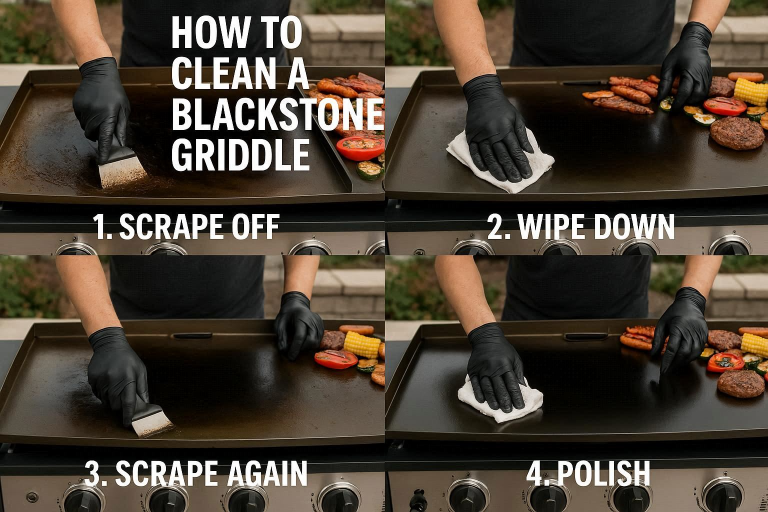If you love outdoor cooking, chances are you’ve heard of the Blackstone griddle. It’s a flat-top grill that makes everything from pancakes and eggs to burgers and steak taste incredible. But like any well-loved cooking tool, it needs the right care after each use.
Cleaning your Blackstone griddle isn’t just about looks—it’s about protecting your investment. A well-cleaned surface lasts longer, holds its seasoning better, and keeps food tasting fresh instead of smoky or burnt from old residue. It also helps prevent rust, which can shorten the life of your griddle if ignored.
Many new owners make the mistake of using soap, harsh scrubbers, or leaving water on the surface, which can strip seasoning and invite rust. Others skip cleaning altogether, thinking a quick scrape is enough. With the right method, though, you can avoid these pitfalls and keep your Blackstone in top shape for years to come.
Why Cleaning Your Blackstone Matters
Keeping your Blackstone griddle clean after cooking does more than make it look nice—it protects the surface and ensures you get the best results every time. A griddle that isn’t cared for will quickly show signs of wear, and that can affect both flavor and performance.
First, regular cleaning helps prevent rust and buildup. Since Blackstone griddles are made of steel, any leftover moisture or food particles can cause Guide to Mastering Everyday Cooking corrosion. By wiping down and oiling the surface, you create a protective barrier that keeps rust away.
Second, a clean griddle means better-tasting meals. Old grease, burnt crumbs, and stuck-on bits can transfer unpleasant flavors to your next cook. By removing these, you ensure your food tastes fresh and delicious every time.
Another key reason to clean is to protect the seasoning. The thin layer of oil baked onto the surface is what makes a Blackstone naturally nonstick. Skipping cleaning or scrubbing too harshly can strip this away, making cooking harder and cleanup messier.
Finally, cleaning extends the lifespan of your griddle. A few minutes of care after each meal helps preserve your investment, so you can keep cooking outdoors for years without problems.
Tools & Materials You’ll Need
Before you start cleaning your Blackstone, it’s smart to have the right tools on hand. Using the proper materials not only makes the job easier but also keeps your griddle in top condition.
A metal scraper or spatula is your first essential tool. It helps you quickly remove food particles and grease without damaging the surface. For tougher spots, a grill stone or scrub pad works well. These are designed to lift stuck-on bits without stripping the seasoning layer you’ve worked hard to build.
Next, keep plenty of paper towels or a microfiber cloth nearby. These are perfect for wiping away grease, water, and residue during the cleaning process. A cloth can be reused, but paper towels are convenient for quick cleanups.
When it comes to loosening debris, hot water is all you need. Avoid soap or harsh cleaners, since they can break down the seasoning and leave your griddle vulnerable to rust. Warm water works with your scraper to wash away stubborn spots naturally.
Finally, don’t forget cooking oil. After cleaning, a thin coat of oil re-seasons the surface and creates a protective barrier against rust. This last step is key to keeping your griddle ready for the next meal.
Step-by-Step Cleaning Process After Cooking
Cleaning your Blackstone after cooking doesn’t have to be complicated. With the right routine, it only takes a few minutes and keeps your griddle in excellent condition. Here’s a simple step-by-step guide:
Step 1: Let the Griddle Cool Slightly
Once you’re done cooking, turn off the heat and let the griddle cool. Wait until it’s warm to the touch but not scorching hot—this makes cleaning safe and effective.
Step 2: Scrape Off Food Residue
Use your metal scraper or spatula to push leftover food and grease toward the grease trap. This removes the bulk of the mess right away.
Step 3: Wipe Down With Water
Pour a small amount of warm water onto the surface to loosen stuck-on bits. Then, scrub gently with a grill stone or pad to lift off anything that remains.
Step 4: Dry the Surface
Use paper towels or a microfiber cloth to soak up water and wipe the griddle completely dry. Removing all moisture prevents rust.
Step 5: Re-Season the Griddle
Finally, apply a thin layer of cooking oil. Spread it evenly across the surface and let it absorb. This step keeps your griddle nonstick and protected for your next meal.
Pro Tips for Keeping Your Blackstone in Top Shape
Once you’ve mastered the basics of cleaning, a few extra habits can make all the difference in keeping your Blackstone griddle performing like new. These pro tips are simple but highly effective.
First, avoid using soap or harsh chemicals. While soap works well in a kitchen sink, it’s not right for a griddle. It can strip away the seasoning layer, leaving the surface bare and prone to rust. Stick with warm water and the right tools instead.
Second, never leave water sitting on the surface. Even a small amount of moisture can cause rust spots to form. Always dry your griddle thoroughly after cleaning and finish with a light coat of oil for extra protection.
Third, make sure to store your griddle with a cover. Outdoor weather, especially rain and humidity, can damage the steel surface. A fitted Blackstone cover keeps out moisture, dust, and debris so your griddle is ready to use anytime.
Lastly, plan for a deep clean every so often. This means heating the griddle, scraping it down, applying water to loosen buildup, and re-seasoning with multiple thin layers of oil. Think of it as a reset that refreshes the cooking surface and keeps food flavors consistent.
Common Mistakes to Avoid
Even with the best intentions, many new Blackstone owners make mistakes that can shorten the life of their griddle. Knowing what to avoid is just as important as learning the proper cleaning steps.
One of the biggest errors is using abrasive steel wool. While it is a good way to scrub off tough spots, steel wool is too harsh for a seasoned surface. It scratches the steel, strips away seasoning, and leaves the griddle vulnerable to rust. Instead, stick with a grill stone, scraper, or non-abrasive scrub pad.
Another common mistake is forgetting to re-season after cleaning. The thin layer of oil you apply at the end of each session is what keeps your griddle naturally nonstick and rust-resistant. Skipping this step can quickly lead to sticky food and a dull, unprotected surface.
Lastly, storing the griddle while damp is a sure way to invite rust. Even if it looks dry, leftover moisture can hide in small spots and cause damage over time. Always wipe the surface completely dry, add a light coat of oil, and cover your griddle before putting it away.
Avoiding these mistakes helps ensure your Blackstone stays reliable, rust-free, and ready for your next meal.
Conclusion
Caring for your Blackstone griddle doesn’t take much time, but it makes all the difference. A few minutes of cleaning after each cook protects the surface, preserves the seasoning, and keeps rust from setting in. More importantly, it ensures that every meal you cook tastes as fresh and flavorful as the first.
By following a simple routine—scraping away food debris, wiping with warm water, drying thoroughly, and finishing with a thin coat of oil—you extend the life of your griddle and save yourself from bigger problems down the road. Think of it as part of the cooking process, not a chore you can skip.
The best approach is to adopt a quick post-cooking cleaning habit. When you make it a regular step, it soon becomes second nature. Your griddle will stay in excellent shape, and you’ll enjoy stress-free cooking sessions without worrying about stubborn buildup or rusty patches.
A well-maintained Blackstone rewards you with years of dependable performance and delicious meals. From hearty breakfasts to backyard cookouts, your griddle will always be ready to deliver. With a little care and consistency, you’ll enjoy the true joy of outdoor cooking on a surface that’s seasoned to perfection.
FAQs
How do you clean a Blackstone grill after cooking?
After cooking, let the griddle cool until it’s warm—not scorching hot. Scrape off food and grease into the trap, add a splash of warm water to loosen stuck bits, scrub gently with a grill stone or pad, then wipe it dry. Finally, apply a thin layer of cooking oil to protect the surface.
What should I avoid when cleaning my Blackstone?
Avoid using soap, harsh chemicals, or abrasive steel wool. These can strip away the seasoning layer and damage the steel surface. Also, never leave water sitting on the griddle—it can cause rust.
How do you clean a Blackstone grill after cooking (according to Reddit users)?
Many Reddit users recommend a simple method: scrape food debris, add warm water while the surface is still hot, scrub lightly, dry it, and re-season with oil. Some even suggest keeping a dedicated squirt bottle of water and oil nearby for fast cleanup.
How often should you clean a Blackstone grill?
You should do a light clean after every use to remove food and grease. A deeper clean—scraping thoroughly, adding water, and re-seasoning with several thin oil layers—can be done every few weeks or whenever buildup starts to affect cooking.

